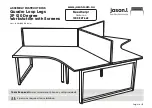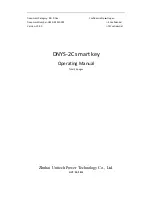
VC
15
©Copyright Eaton Corp., 2019. All rights reserved.
4.1.1.2
Contamination of Shoes or Drum
- Oil or grease
contamination will reduce the developed torque of
the clutch or brake. Disassembly will be required to
clean any oil or grease buildup. In extremely dusty
environments, dust may accumulate in the backing
plate cavities to the point where the friction shoes
will not properly retract. Dust accumulations may be
vacuumed out of the cavities.
⚠
CAUTION
Do not attempt to use a solvent to remove oil or
grease without first removing the element.
While squirting a solvent into an installed clutch
or brake may improve performance temporarily,
a fire hazard exists from the heat generated
during slippage.
⚠
CAUTION
Do not use compressed air to blow dust
accumulations out of the backing plates.
Although the friction material does not contain
asbestos, the dust created as the friction
material wears, along with the dust from the
operating environment, may irritate the
respiratory system.
4.1.1.3
Air Control Components
- Check for proper
adjustment of the air control components. Make
sure the safety pressure switches, if used are set
correctly. Repair any air leaks as discovered.
4.1.2
Partial or complete disassembly is required to
inspect the following items:
4.1.2.1
Drum Diameter Wear
- Check the O.D. of the drum
and compare to the values shown on Table 6.
Minor heat-checking may be removed by machining
the drum O.D. If the drum has been subjected to
excessive heat, the open end may flare out, giving
the impression that the drum has not worn. It is
therefore important to check the diameter at several
locations across the face.
TABLE 6
DRUM WEAR LIMITS
NARROW SERIES
Element Size
Minimum Allowable Wear on
Drum Diameter*
inch (mm)
11.5VC500 thru 16VC600
0.09 (2)
20VC600 thru 24VC650
28VC650
0.19 (5)
33VC656 thru 42VC650
WIDE SERIES
12VC1000 thru 16VC1000
0.09 (2)
20VC1000 thru 24VC1000
0.13 (3)
28VC1000
0.19 (5)
32VC1000 thru 38VC1200
42VC1200 thru 46VC1200
0.25 (6)
52VC1200 thru 76VC2000
*
Note
: The number preceding the letters ‘VC” in the element size
designates the original drum diameter in inches.
Example: 16VC600 - Original Drum Diameter = 16.00 inches
(406 mm).
Minimum allowable drum diameter is:
16 inch (406 mm) - 0.09 inch (2 mm) = 15.91inch (404 mm).
⚠
CAUTION
Operation of the clutch or brake on a drum that
has worn or has been machined to less that
minimum allowable diameter will result in
damage to the element components.
4.1.2.2
Air Actuating Tube
- Check that the tube has not
been damaged by excessive heat. If any portion of
the tube is hard or charred, the tube must be
replaced. Check for any blisters, which would
indicate ply separation. A tube in this condition
must also be replaced.
4.1.2.3
Friction Shoe Lining Wear
- If the linings are
glazed, they may be lightly sanded to remove the
glazing PROVlDlNG THEY DO NOT CONTAlN
ASBESTOS.
⚠
WARNING
Clean the edge of the lining and note the
presence of a blue stripe and a white stripe
along with brass flakes in the friction material. If
the above exists, the linings contain asbestos.
Using the appropriate precautions for working
with asbestos, remove the linings and dispose
of properly. DO NOT ATTEMPT TO SAND
FRICTION MATERIAL CONTAINING ASBESTOS.
⚠
CAUTION
When working with any friction material,
regardless of whether or not it contains
asbestos, always wear approved safety
equipment.
4.1.2.4
Uneven Friction Lining Wear
- Tapered wear
across the friction surface typically indicates a worn
drum and/or misalignment. If two or more adjacent
shoes are worn on one end only, the air actuating
tube has most likely developed a ply separation at
that location.
















































